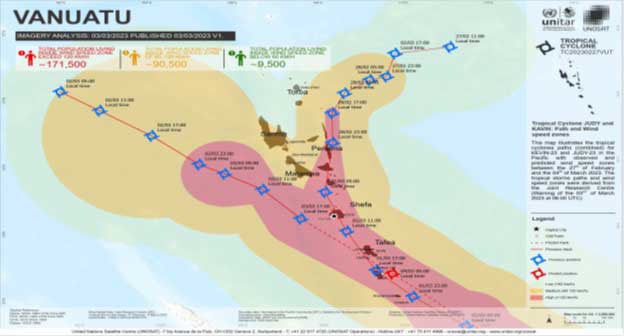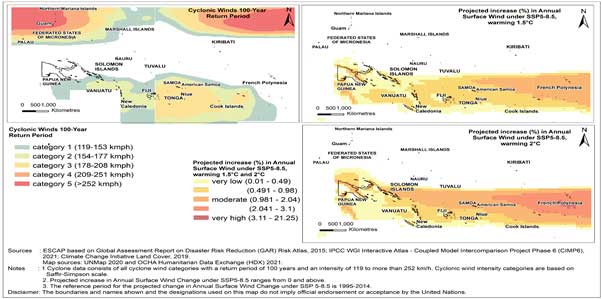Vanuatu Twin Cyclones Underscore the Pacific's Vulnerability to Compounding Climate-Disaster Risks

BANGKOK, Thailand, Mar 10 (IPS) - Two destructive Category 4 tropical cyclones, Judy and Kevin, and an earthquake of 6.5 magnitude impacted over 80 per cent of the Vanuatu population from 1 to 3 March 2023. To address this emergency situation, the UN, along with Pacific member States have deployed personnel on the ground to coordinate humanitarian assistance and prepare post-disaster damage assessment.
Sitting in the Pacific “Ring of Fire,” Vanuatu experiences frequent volcanic and seismic activity. And along with the other Pacific small island developing States (SIDS), Vanuatu faces existential threats due to rising sea level, ocean acidification and the increased frequency and severity of natural disasters and is on the front line of climate crisis.
The twin cyclones and an earthquake in just 48 hours remind the world that seismic and climate risks are converging and intensifying – no community feels this stronger than those of the Blue Pacific Continent.
On macro-economic impact, in fact, Pacific SIDS face Average Annual Losses from multiple hazards totaling to US$ 1.1 billion in the current scenario. This figure is set to increase to US$ 1.3 billion under moderate and US$1.4 billion under worst-case climate warming scenarios. As a percentage of GDP, Vanuatu, Tonga and Palau are projected to face highest losses - Vanuatu is projected to lose a staggering 20 per cent GDP annually due to disasters.

Intensifying and expanding climate crisis
In ESCAP’s recent report, the analysis shows that at 1.5 to 2.0 °C warming, there are likely intensifying annual wind speeds of tropical cyclones and that the risk of tropical cyclones is expected to expand and include newer areas beyond the historical tracks (Figure 2). Vanuatu in particular, will experience higher risk of tropical cyclone both in terms of the intensification as well as geographic expansion of the riskscape.
As cyclone hazards are intensifying and deviating from their traditional tracks, their greater complexity results in deeper uncertainties in the ability to predict. Our Blue Pacific Continent is not sufficiently prepared.

Formulating transformative actions
As the climate changes, the riskscape is transforming. These disaster risks compound and cascade to amplify the great hardship experienced by the Pacific SIDS in terms of population and critical infrastructure exposure. The argument for transformative action to mitigate and adapt to intensifying and expanding disaster risks in the Blue Pacific Continent has never been more compelling.
First, early warning for all is an imperative, needs to capture compounding risks.
The UN Secretary-General highlighted that every person on the planet is to be covered by early warning systems by 2027. The Sendai Framework for Disaster Risk Reduction sets the increase in availability and access to of multi?hazard early warning systems as a distinct target, Target G, to be achieved by 2030. As per the latest Sendai Framework reporting of Target G, large gaps remain for many countries in the Pacific SIDS (See Figure 3).
Relative to other countries in the subregion, Vanuatu’s Target G scores are high, reporting substantial to comprehensive coverage of multi-hazard early warning systems across all indicators. WMO’s Regional Specialized Meteorological Centre in Nadi, Fiji was providing early warnings in the face of power outages and surmounting uncertainties – as a result, there have been no reported fatalities.

Second, transformative adaptation solutions are needed.
To minimize and prevent systemic and cascading risk, we need to make new infrastructure and water resource management more resilient. Improving dryland crop production and using nature-based solutions such as increasing mangroves protection are also priority adaptation solutions.
1.5 per cent of GDP for adaptation investment is estimated to be needed in Pacific SIDS - three times less than the average losses projected. These adaptation investments must be risk-informed and strategically directed towards policy actions that yield high cost-benefits. Where there are multi-hazard risk hotspots across the region, risk-informed policy and transformative actions should capitalize on inter-sectoral synergies and co-benefits.
Third, the 2050 Strategy for the Blue Pacific Continent provides a clear pathway
With the adoption of the 2050 Strategy for the Blue Pacific Continent in July 2022, Pacific SIDS have developed a clear pathway to synergize regional priorities with accelerated implementation of the 2030 Agenda for Sustainable Development, the Sendai Framework for Disaster Risk Reduction and the SAMOA Pathway.
Next generation risk analytics, advances in climate science, geo-spatial modeling, Artificial Intelligence and machine learning must be at the heart of people-centered and evidence-based decision-making. And, the Framework for Resilient Development in the Pacific is an ideal platform to take forward some of the policy decisions.
Strengthening subregional and regional cooperation platform
Tropical cyclones, often transboundary in nature, require an architecture of regional co-operation mechanisms to effectively manage the shared risks. In this instance, local capacities and regional support mechanisms should be commended. To further strengthen this work, the lesson from Vanuatu’s back-to-back cyclones and earthquake is to have effective, impact-based and risk informed early warning systems that can capture the complexity and dynamisms of a compounding risk.
The Asia-Pacific Risk and Resilience Portal was developed by ESCAP with the goal of creating a user-friendly one stop platform for policymakers to access a vast array of scientific information and decision support tools to promote risk informed policy decisions.
Furthermore, the Vanuatu incidents underscores the need for conducting a rapid post-disaster needs assessment that can support formulation of a long-term recovery strategy and plan for its reconstruction by applying a standardized approach with innovative methodology and framework.
The overlapping and transboundary nature of risks experienced by countries of the Blue Pacific Continent cannot be addressed without solidarity and collective action towards strengthening regional cooperation platform.
Sanjay Srivastava is Chief, Disaster Risk Reduction, United Nations Economic and Social Commission for Asia and the Pacific (ESCAP);
Sudip Ranjan Basu is Deputy Head, ESCAP Subregional Office for the Pacific
IPS UN Bureau
Follow @IPSNewsUNBureau
Follow IPS News UN Bureau on Instagram
© Inter Press Service (2023) — All Rights Reserved. Original source: Inter Press Service
 Global Issues
Global Issues